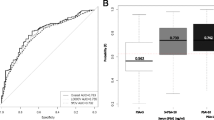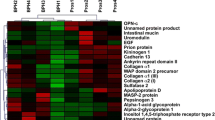Abstract
Objective
To measure a combination of novel molecular biomarkers in urine/blood samples of consecutive patients referring lower urinary tract symptoms (LUTS) not previously diagnosed, to improve prostate cancer diagnosis.
Methods
Serum and urine samples from 113 men who went consecutively to the Department of Urology of our Institution. Biomarkers analyzed were AMACR and MMP-2 levels, and GSTP1/RASSF1A methylation status, in addition to PSA levels. Sensitivity, specificity, area under the ROC (AUROC) curves, and discriminant function analysis were assessed to determine the diagnostic potential of each variable alone or in combination.
Results
Of the patients, 30.08% had PCa and the remaining ones were tumor free. Areas under the ROC (AUROC) curves were as follows: 0.476 for PSA, 0.532 for AMACR, and 0.706 for MMP-2. Sensitivity and specificity for methylation status were 53.3 and 45.9%, respectively. The combination of these biomarkers resulted in an AUROC curve of 0.788, which significantly outperformed AUROC curves for PSA (P = 0.0033) and AMACR (P = 0.0375). Sensitivity, specificity, positive and negative predictive values for the combination of biomarkers were 57.1, 96.6, 88.9, and 82.4%, respectively.
Conclusion
We conclude that analysis of this biomarker combination in body fluids improves very significantly the diagnosis of PCa compared to the PSA test.

Similar content being viewed by others
References
Lilja H, Ulmert D, Vickers AJ (2008) Prostate-specific antigen and prostate cancer: prediction, detection and monitoring. Nat Rev Cancer 8(4):268–278
Loeb S, Catalona WJ (2008) What to do with an abnormal PSA test. Oncologist 13(3):299–305
Thompson IM, Chi C, Ankerst DP et al (2006) Effect of finasteride on the sensitivity of PSA for detecting prostate cancer. J Natl Cancer Inst 98(16):1128–1133
Thompson IM, Pauler DK, Goodman PJ et al (2004) Prevalence of prostate cancer among men with a prostate-specific antigen level < or =4.0 ng per milliliter. N Engl J Med 350(22):2239–2246
Aus G, Damber JE, Khatami A, Lilja H, Stranne J, Hugosson J (2005) Individualized screening interval for prostate cancer based on prostate-specific antigen level: results of a prospective, randomized, population-based study. Arch Intern Med 165(16):1857–1861
Ulmert D, Serio AM, O’Brien MF et al (2008) Long-term prediction of prostate cancer: prostate-specific antigen (PSA) velocity is predictive but does not improve the predictive accuracy of a single PSA measurement 15 years or more before cancer diagnosis in a large, representative, unscreened population. J Clin Oncol 26(6):835–841
Djavan B, Margreiter M (2007) Biopsy standards for detection of prostate cancer. World J Urol 25(1):11–17
Laxman B, Morris DS, Yu J et al (2008) A first-generation multiplex biomarker analysis of urine for the early detection of prostate cancer. Cancer Res 68(3):645–649
Sreekumar A, Laxman B, Rhodes DR et al (2004) Humoral immune response to alpha-methylacyl-CoA racemase and prostate cancer. J Natl Cancer Inst 96(11):834–843
Nelson AR, Fingleton B, Rothenberg ML, Matrisian LM (2000) Matrix metalloproteinases: biologic activity and clinical implications. J Clin Oncol 18(5):1135–1149
Stearns ME, Stearns M (1996) Immunohistochemical studies of activated matrix metalloproteinase-2 (MMP-2a) expression in human prostate cancer. Oncol Res 8(2):63–67
Costa VL, Henrique R, Jeronimo C (2007) Epigenetic markers for molecular detection of prostate cancer. Dis Markers 23(1–2):31–41
Hoque MO, Topaloglu O, Begum S et al (2005) Quantitative methylation-specific polymerase chain reaction gene patterns in urine sediment distinguish prostate cancer patients from control subjects. J Clin Oncol 23(27):6569–6575
Jeronimo C, Usadel H, Henrique R et al (2002) Quantitative GSTP1 hypermethylation in bodily fluids of patients with prostate cancer. Urology 60(6):1131–1135
Bensalah K, Lotan Y, Karam JA, Shariat SF (2008) New circulating biomarkers for prostate cancer. Prostate Cancer Prostatic Dis 11(2):112–120
Shah RB, Mehra R, Chinnaiyan AM et al (2004) Androgen-independent prostate cancer is a heterogeneous group of diseases: lessons from a rapid autopsy program. Cancer Res 64(24):9209–9216
Tinzl M, Marberger M, Horvath S, Chypre C (2004) DD3PCA3 RNA analysis in urine—a new perspective for detecting prostate cancer. Eur Urol 46(2):182–186 (discussion 7)
Henrique R, Jeronimo C (2004) Molecular detection of prostate cancer: a role for GSTP1 hypermethylation. Eur Urol 46(5):660–669 (discussion 9)
Lazcoz P, Munoz J, Nistal M, Pestana A, Encio I, Castresana JS (2006) Frequent promoter hypermethylation of RASSF1A and CASP8 in neuroblastoma. BMC Cancer 6:254
Tokumaru Y, Harden SV, Sun DI, Yamashita K, Epstein JI, Sidransky D (2004) Optimal use of a panel of methylation markers with GSTP1 hypermethylation in the diagnosis of prostate adenocarcinoma. Clin Cancer Res 10(16):5518–5522
Morgia G, Falsaperla M, Malaponte G et al (2005) Matrix metalloproteinases as diagnostic (MMP-13) and prognostic (MMP-2, MMP-9) markers of prostate cancer. Urol Res 33(1):44–50
Acknowledgments
This work has been funded by “UTE project CIMA”, ISCIII-RETIC RD06/0020 grant; Gobierno de Navarra-Salud; Gobierno de Navarra-Educacion; Fundacion Mutua Madrileña; and Ministerio de Educacion y Ciencia (grant SAF2007-64184).
Conflict of interest statement
The authors declare that they have no conflict of interest.
Author information
Authors and Affiliations
Corresponding author
Rights and permissions
About this article
Cite this article
Prior, C., Guillen-Grima, F., Robles, J.E. et al. Use of a combination of biomarkers in serum and urine to improve detection of prostate cancer. World J Urol 28, 681–686 (2010). https://doi.org/10.1007/s00345-010-0583-x
Received:
Accepted:
Published:
Issue Date:
DOI: https://doi.org/10.1007/s00345-010-0583-x




